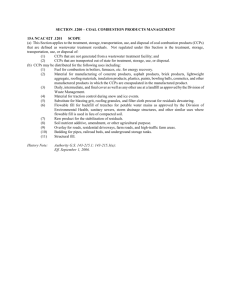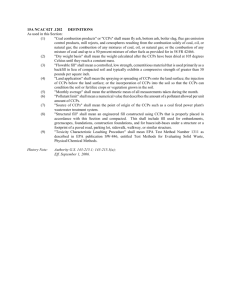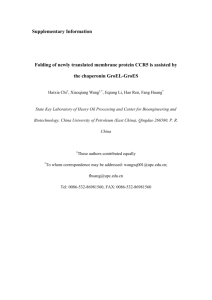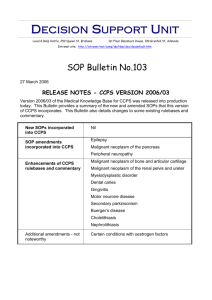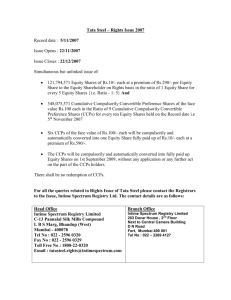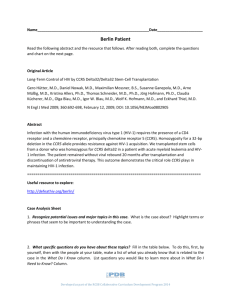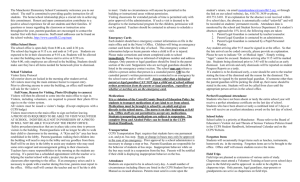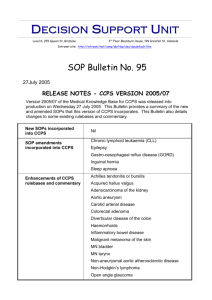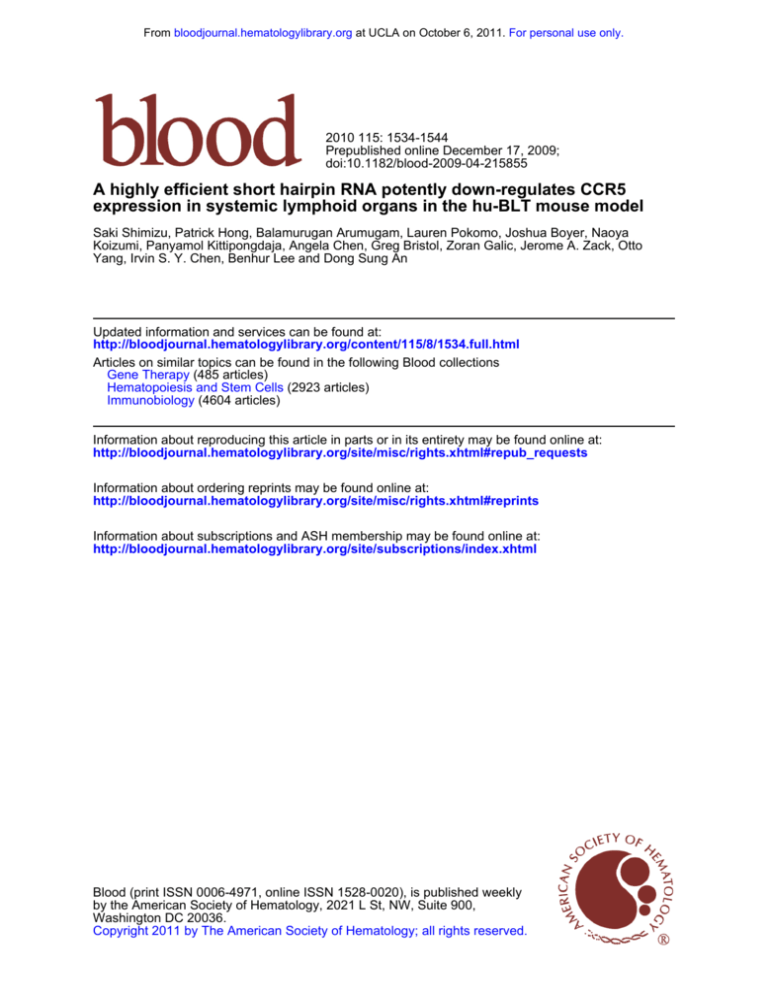
From bloodjournal.hematologylibrary.org at UCLA on October 6, 2011. For personal use only.
2010 115: 1534-1544
Prepublished online December 17, 2009;
doi:10.1182/blood-2009-04-215855
A highly efficient short hairpin RNA potently down-regulates CCR5
expression in systemic lymphoid organs in the hu-BLT mouse model
Saki Shimizu, Patrick Hong, Balamurugan Arumugam, Lauren Pokomo, Joshua Boyer, Naoya
Koizumi, Panyamol Kittipongdaja, Angela Chen, Greg Bristol, Zoran Galic, Jerome A. Zack, Otto
Yang, Irvin S. Y. Chen, Benhur Lee and Dong Sung An
Updated information and services can be found at:
http://bloodjournal.hematologylibrary.org/content/115/8/1534.full.html
Articles on similar topics can be found in the following Blood collections
Gene Therapy (485 articles)
Hematopoiesis and Stem Cells (2923 articles)
Immunobiology (4604 articles)
Information about reproducing this article in parts or in its entirety may be found online at:
http://bloodjournal.hematologylibrary.org/site/misc/rights.xhtml#repub_requests
Information about ordering reprints may be found online at:
http://bloodjournal.hematologylibrary.org/site/misc/rights.xhtml#reprints
Information about subscriptions and ASH membership may be found online at:
http://bloodjournal.hematologylibrary.org/site/subscriptions/index.xhtml
Blood (print ISSN 0006-4971, online ISSN 1528-0020), is published weekly
by the American Society of Hematology, 2021 L St, NW, Suite 900,
Washington DC 20036.
Copyright 2011 by The American Society of Hematology; all rights reserved.
From bloodjournal.hematologylibrary.org at UCLA on October 6, 2011. For personal use only.
GENE THERAPY
A highly efficient short hairpin RNA potently down-regulates CCR5 expression in
systemic lymphoid organs in the hu-BLT mouse model
Saki Shimizu,1,2 Patrick Hong,2,3 Balamurugan Arumugam,2,3 Lauren Pokomo,1,2 Joshua Boyer,1,2 Naoya Koizumi,1,2
Panyamol Kittipongdaja,1,2 Angela Chen,4 Greg Bristol,1,2 Zoran Galic,1,2 Jerome A. Zack,1-3 Otto Yang,2,3 Irvin S. Y. Chen,1-3
Benhur Lee,2,3 and Dong Sung An1,2
1Department
4Obstetrics
of Medicine, Division of Hematology-Oncology, 2UCLA AIDS Institute, and Departments of 3Microbiology, Immunology and Molecular Genetics and
& Gynecology, David Geffen School of Medicine, University of California, Los Angeles
Inhibiting the expression of the HIV-1
coreceptor CCR5 holds great promise for
controlling HIV-1 infection in patients.
Here we report stable knockdown of human CCR5 by a short hairpin RNA (shRNA)
in a humanized bone marrow/liver/thymus (BLT) mouse model. We delivered a
potent shRNA against CCR5 into human
fetal liver-derived CD34ⴙ hematopoietic
progenitor/stem cells (HPSCs) by lentiviral vector transduction. We transplanted
vector-transduced HPSCs solidified with
Matrigel and a thymus segment under the
mouse kidney capsule. Vector-transduced
autologous CD34ⴙ cells were subsequently injected in the irradiated mouse,
intended to create systemic reconstitution. CCR5 expression was downregulated in human T cells and monocytes/macrophages in systemic lymphoid
tissues, including gut-associated lymphoid tissue, the major site of HIV-1 replication. The shRNA-mediated CCR5 knockdown had no apparent adverse effects on
T-cell development as assessed by polyclonal T-cell receptor V family develop-
ment and naive/memory T-cell differentiation. CCR5 knockdown in the secondary
transplanted mice suggested the potential of long-term hematopoietic reconstitution by the shRNA-transduced HPSCs.
CCR5 tropic HIV-1 infection was effectively inhibited in mouse-derived human
splenocytes ex vivo. These results demonstrate that lentiviral vector delivery of
shRNA into human HPSCs could stably
down-regulate CCR5 in systemic lymphoid organs in vivo. (Blood. 2010;115:
1534-1544)
Introduction
Chemokine receptor CCR5 is an attractive therapeutic target for
inhibiting HIV-1, as it serves as a HIV-1 coreceptor and is essential
for CCR5 tropic HIV-1 infection.1-4 Blocking CCR5 expression
should prevent HIV-1 infection at the initial stage of the viral life
cycle. Individuals with a ⌬32/⌬32 homozygous mutation in the
CCR5 gene do not express CCR5, are highly protected from HIV-1,
and are apparently normal.5-7 Recently, an HIV⫹ acute myelogenous leukemia patient was treated for leukemia and HIV infection
by bone marrow transplantation using donated CCR5 ⌬32/⌬32
marrow. After the transplantation, nearly 100% of the patient’s
blood cells were replaced with donor cells. HIV DNA and RNA
were undetectable at 20 months, even after the discontinuation of
highly active antiretroviral therapy.8 This evidence supports that
long-term and stable reduction of CCR5 is a promising strategy for
treating HIV-infected patients. The major limitation of this strategy
is the difficulty of identifying human leukocyte antigen–matched
CCR5 ⌬32/⌬32 homozygous donors as the mutation exists in
approximately 1% of white populations and is rare in other ethnic
populations.9
Small interfering RNAs (siRNAs) induce sequence-specific
degradation of mRNAs by RNA interference.10 Many forms of
siRNA have been used to inhibit HIV coreceptors and HIV-1 gene
expression in in vitro and in vivo experimental settings.11-18 To
stably inhibit HIV replication, we and others developed lentiviral
vectors that are capable of stably delivering short hairpin RNA
(shRNA) in mammalian cells.19-25 We demonstrated that expression
of CCR5-specific shRNA in human primary T lymphocytes results
in efficient CCR5-knockdown and protection of cells from HIV-1
infection in vitro.22 However, we and others recognized that a high
level of sustained shRNA expression may be toxic to cells because
of competition with endogenous micro-RNA biogenesis, induction
of interferon responses, and/or off-targeting effects.23,26-33 To stably
reduce CCR5 expression without cytotoxicity, we identified a
highly efficient shRNA (shRNA 1005) directed to human CCR5
mRNA using the enzymatic production of RNAi libraries (EPRIL)
screening technique.21,34 We expressed shRNA 1005 using the
transcriptionally weak H1 promoter to stably reduce CCR5 expression without inducing cytotoxicity in human primary peripheral
blood lymphocytes in vitro.21,34 To test stable CCR5 reduction in
vivo, we used a nonhuman primate hematopoietic stem cell
transplantation model in which we were able to demonstrate stable
reduction of CCR5 expression in peripheral blood lymphocytes in
shRNA-transduced CD34⫹ cell-transplanted rhesus macaques.21
Because of a single nucleotide mismatch in the shRNA 1005 target
sequence between human and rhesus macaque CCR5 mRNA, we
mutated the human CCR5 shRNA 1005 so that it would be 100%
homologous to the corresponding rhesus macaque CCR5 mRNA
target sequence. This rhesus macaque-specific shRNA 1005 inhibited rhesus macaque CCR5 expression but not human CCR5
expression.21
In this study, we used a recently developed humanized bone
marrow/liver/thymus (hu-BLT) mouse model to examine the
Submitted April 9, 2009; accepted November 15, 2009. Prepublished online as
Blood First Edition paper, December 17, 2009; DOI 10.1182/blood-2009-04-215855.
The publication costs of this article were defrayed in part by page charge
payment. Therefore, and solely to indicate this fact, this article is hereby
marked ‘‘advertisement’’ in accordance with 18 USC section 1734.
The online version of this article contains a data supplement.
© 2010 by The American Society of Hematology
1534
BLOOD, 25 FEBRUARY 2010 䡠 VOLUME 115, NUMBER 8
From bloodjournal.hematologylibrary.org at UCLA on October 6, 2011. For personal use only.
BLOOD, 25 FEBRUARY 2010 䡠 VOLUME 115, NUMBER 8
down-regulation of human CCR5 expression using shRNA 1005
against human CCR5 mRNA.35,36 Unlike other humanized mouse
models, this model allows us to examine the effects of shRNA
expression during T-cell differentiation in the transplanted tissue
thymus and liver (thy/liv). We found that differentiated T cells were
able to migrate systemically and develop functional primary and
secondary lymphoid organs. We demonstrated here that an implant
of lentiviral vector–mediated CCR5 shRNA-transduced CD34⫹
cells did result in efficient and stable CCR5-knockdown in multiple
lymphoid organs, including in gut-associated mucosal lymphoid
tissues, without causing apparent adverse effects. We found that the
CCR5 knockdown was sufficient to inhibit CCR5 tropic HIV-1
infection in isolated splenocytes ex vivo.
Methods
Lentiviral vector construction and production
The construction of lentiviral vector FG12 H1shRNACCR5 (1005) was
previously described.21,37 Briefly, we generated a random shRNA library
directed to human CCR5 mRNA sequences by adapting the EPRIL method,
which were then expressed using a lentiviral vector with an H1 promoter. A
total of 400 clones of a vesicular stomatitis virus-G pseudotyped lentiviral
vector were individually produced and screened for efficient CCR5
knockdown using CEM.NKR-CCR5 cells in 96-well plates. The most
effective clone (human CCR5-shRNA(1005)) sequence consisted of
5⬘ sense siRNA-GAGCAAGCTCAGUUUACACC-loop-UUGUCCGACantisense siRNA-GGUGUAAACUGAGCUUGCUC-UU3⬘. To express the
mCherry fluorescent protein from a lentiviral vector, mCherry cDNA was
extracted from pmCherry (Clontech) using the BamHI and EcoRI sites and
cloned into the corresponding sites of the FG11F lentiviral vector.22 High
titer (⬎ 3 ⫻ 108 enhanced green fluorescent protein [EGFP]⫹ or mCherry⫹
units/mL) vesicular stomatitis virus-G pseudotyped lentiviral vectors were
prepared by calcium phosphate plasmid DNA transfection in 293T cells as
previously described.22 The concentrated vector stocks were titered on
293T cells based on EGFP or mCherry expression.
Human fetal thymus and CD34ⴙ and CD34ⴚ cell isolation from a
fetal liver
Human fetal liver and thymus were obtained without identification information under federal and state regulations from the University of California,
Los Angeles (UCLA) CFAR Gene and Cellular Therapy Core Laboratory
and UCLA OB-GYN. Human fetal liver was digested with 1 mg/mL
hyaluronidase (Sigma-Aldrich), 1 mg/mL collagenase type IV (SigmaAldrich), and 2 units/mL DNase I (Roche Diagnostics) containing AIM-V
medium (Invitrogen) for 2 hours. To avoid bacterial and fungal contamination, human fetal tissues and cells were cultured with 450 g/mL Zosyn
(Wyeth) and 2.5 g/mL amphotericin B (Sigma-Aldrich) in appropriate
medium. Fetal liver mononuclear cells were separated by a Ficoll-Hypaque
(GE Healthcare) density gradient. CD34⫹ and CD34⫺ cells were separated
using the magnetic-activated cell sorting Direct CD34 Progenitor Cell
Isolation Kit (Miltenyi Biotec) according to the manufacturer’s instructions.
The purity of CD34⫹ cells was more than 97% as evaluated by fluorescenceactivated cell sorter (FACS).
Lentiviral vector transduction
CD34⫹ (0.5 ⫻ 106) and CD34⫺ cells (4.5 ⫻ 106) from a single fetal liver
were seeded into RetroNectin (Takara)-coated plates with 2% bovine serum
albumin in Yssel’s medium (Gemini). After a 1-hour incubation, cells were
infected with either the FG12 H1shRNACCR5 (1005) or FG11FmCherry
lentiviral vector at multiplicity of infection (MOI) of 0.2 to 3 for overnight.
Generation of hu-BLT mice
NOD.CB17-Prkdcscid/J and NOD.Cg-Prkdcscid Il2rgtm1Wjl/SzJ mice were
purchased from The Jackson Laboratory and maintained in the animal
STABLE CCR5 KNOCKDOWN BY RNA INTERFERENCE
1535
facilities at UCLA in accordance with protocols approved by the UCLA
animal research committee. hu-BLT mice were prepared as previously
described35 with modifications for the implantation of the vector-transduced
thy/liv organoid under the kidney capsule. Six- to 8-week-old male mice
were implanted with a portion of human fetal thymus and Matrigelsolidified lentivirally transduced CD34⫹ (0.5 ⫻ 106) and CD34⫺ cells
(4.5 ⫻ 106) within 5 L of Matrigel (BD Biosciences) under the kidney
capsule. Three weeks after implantation, CD34⫹/CD34⫺/thymus-implanted
mice were irradiated (325 cGy by 60Co irradiation) and transplanted with
lentivirus vector–transduced autologous human CD34⫹ cells (1 ⫻ 106)
using a 26-gauge needle through the tail vein or retro-orbital vein.
Serial transplantation of bone marrow–derived cells in the
hu-BLT mouse model
Recipient mice (in duplicate) were prepared in an identical fashion using
nontransduced thy/liv tissue. BLT mouse donor bone marrow cells were
isolated from femurs of a vector-transduced BLT donor at 14 weeks after
CD34⫹ cell transplantation. The BLT donor bone marrow cell suspension
(volume 575 L) was both directly injected into the thy/liv implant
(volume 25 L) and intravenously (volume 50 L) into the irradiated
recipient mice at 18 weeks after thy/liv transplantation.
Cell isolation from peripheral blood, bone marrow, thy/liv,
lymph node, spleen, lung, liver, and intestines
Single-cell suspensions were prepared from peripheral blood, bone marrow,
thy/liv, lymph nodes, spleen, lung, liver, and intestines, as previously described
with modifications.35,38 Mouse peripheral blood was stained with antibodies for
30 minutes, treated with red blood cell lysis (RBCL; 4.15 g of NH4Cl, 0.5 g of
KHCO3, and 0.019 g of ethylenediaminetetraacetic acid in 500 mL of H2O)
buffer for 10 minutes and washed with FACS buffer. Bone marrow, thy/liv
implant, lymph nodes, and spleen mononuclear cells were finely minced into
small fragments and resuspended in 5 mL of RPMI 1640. The supernatant was
filtered through a 70-m cell strainer. The pellet was washed in FACS buffer
(2% fetal calf serum in phosphate-buffered saline [PBS]) and resuspended in
RBCL buffer for 10 minutes. The cells were centrifuged at 1500g for 2 minutes
and washed with FACS buffer. Lung lobes were minced into small pieces with
scissors, treated with collagenase type IV, passed through a 16-gauge needle, and
filtered through a 70-m cell strainer. Cells were resuspended in RPMI 1640, laid
over the 70% of Percoll/PBS, and centrifuged at 2000g for 20 minutes. The pellet
was washed in FACS buffer. The liver was minced into small fragments and
passed through a 16-gauge needle and filtered through a 70-m cell strainer.
Cells were resuspended in RPMI 1640, laid over the 70% of Percoll/PBS, and
centrifuged at 2000g for 20 minutes. Cells were treated with RBCL buffer and
filtered through a 70-m cell strainer and washed with FACS buffer. The small
intestine was flushed in ice-cold PBS, cut into small fragments, and inverted to
expose the intraepithelial surface. These fragments were shaken gently for
30 minutes at 37°C in buffer (10mM N-2-hydroxyethylpiperazine-N⬘-2ethanesulfonic acid; Invitrogen), 5mM ethylenediaminetetraacetic acid (Nippon
Gene), and 3% fetal calf serum in Hanks balanced salt solution (Mediatech Inc).
The fragments were incubated with lamina propria lymphocyte (LPL) digestion
medium (500 g/mL collagenase type II, Sigma-Aldrich; and 10 units/mL
DNase I in RPMI 1640) for 60 minutes at 37°C. The supernatants were collected
through a 70-m cell strainer. Isolated LPL cells were suspended in 40% of
Percoll/Dulbecco modified Eagle medium. Cell suspension was laid over the
70% of Percoll/PBS and centrifuged at 2000g for 20 minutes. LPL cells were
washed with FACS buffer.
Flow cytometry
All isolated tissue mononuclear cells were stained with monoclonal
antibodies to human CCR5 conjugated with PE-Cy5 (2D7; BD Biosciences), CD45 conjugated with biotin or APC (HI30; eBioscience), CD4
conjugated with PE-Cy7 (SK3; BD Biosciences) or APC-Cy7 (RPA-T4;
eBioscience), CD8 conjugated with APC (RPA-T8; BD Biosciences),
PerCP or PE-Cy5 (HIT8a; BD Biosciences), CD45RA conjugated with
PE-Cy7 (L48; BD Biosciences), CD27 conjugated with PE (M-T271; BD
Biosciences), CD19 conjugated with PerCP (SJ25C1; BD Biosciences),
From bloodjournal.hematologylibrary.org at UCLA on October 6, 2011. For personal use only.
1536
SHIMIZU et al
BLOOD, 25 FEBRUARY 2010 䡠 VOLUME 115, NUMBER 8
Figure 1. Diagram of generating a lentiviral vector–
transduced HPSC-transplanted hu-BLT mouse. CD34⫹
and CD34⫺ cells isolated from a human fetal liver were
transduced by either shRNA (EGFP⫹) or no shRNA
(mCherry⫹) vectors. The transduced cells were solidified
with Matrigel and implanted under a kidney capsule with a
piece of human fetal thymus. Three weeks after the
implantation, the mouse was irradiated and intravenously
injected with vector-transduced autologous CD34⫹ cells.
FL indicates human fetal liver segment; and FT, human
fetal thymus segment.
CD33 conjugated with PE-Cy7 (P67.6; eBioscience), CD14 conjugated
with PE (M5E2; BD Biosciences), and CD3 conjugated with PerCP (SK7;
BD Biosciences) according to the manufacturer’s instructions. The cells
were then washed in FACS buffer twice, stained with Streptavidin
AlexaFluor 350 (Invitrogen), washed again with FACS buffer, and fixed
with 2% formaldehyde in PBS. EGFP, mCherry, and antibody tagged
receptor expressions were examined on the FC500 (Beckman Coulter),
LSRII, or FACS Vantage (BD Biosciences). The data were analyzed by
FlowJo (TreeStar) software.
HIV-1 production and infection ex vivo
HIV-1NL4-339 and HIV-1NFNSX SL940,41 were produced by calcium phosphate
transfection in 293T cells. The virus supernatants were filtered with
0.22-m filters and stored at ⫺80°C. Infectious titers were determined by
infecting phytohemagglutinin (PHA)/interleukin-2–activated human peripheral blood mononuclear cells using serially diluted viruses. For the ex vivo
infection, CD8-depleted PHA/interleukin-2–activated splenocytes were
infected with HIV-1 at an MOI of 2.5 for 2 hours.
TCR repertoire analysis
Lentiviral vector–transduced EGFP and mCherry⫹ cells were flowsorted using FACS vantage from the bulk mononuclear cells separated
from thy/liv tissues. The total RNA was isolated from these sorted cells
using Trizol-LS reagent (Invitrogen) per the manufacturer’s recommendations, and cDNA was prepared using 20 L of this total RNA by a
high-capacity cDNA reverse transcription kit (Applied Biosystems). To
Figure 2. Human hematopoietic differentiation of shRNA 1005-transduced HPSCs in multiple lymphoid organs. EGFP and mCherry reporter gene expression was
examined in human CD45⫹ cells in gated lymphocyte population in multiple tissues. Samples were analyzed between 14 and 20 weeks after intravenous CD34⫹ cell injection.
Mean percentage EGFP and percentage mCherry expression are shown in each organ. No significant difference was found (P ⬎ .05) between percentage EGFP⫹ and
percentage mCherry⫹ cells in various tissues by Student t test. Data were generated from n ⫽ 4 to 10 individual animals from an aggregate of 8 donors. Error bar represents
SD. PB indicates peripheral blood; Thy/Liv, transplanted human thy/liv organoid; BM, bone marrow; SL, spleen; LN, lymph nodes; SI LPL, small intestine lamina propria
lymphocytes; and n, number of samples.
From bloodjournal.hematologylibrary.org at UCLA on October 6, 2011. For personal use only.
BLOOD, 25 FEBRUARY 2010 䡠 VOLUME 115, NUMBER 8
STABLE CCR5 KNOCKDOWN BY RNA INTERFERENCE
1537
Figure 3. Polyclonal human TCRv development in thymocytes differentiated from shRNA 1005-transduced HPSCs. Total RNA isolated from FACS-purified EGFP⫹ or
mCherry⫹ thymocytes taken from thy/liv organoids of 3 reconstituted BLT mice were subjected to a quantitative PCR-based TCR spectratyping analysis. Peak ratio was
compared with the median of each TCR V family between EGFP⫹ and mCherry⫹ thymocytes. There was no significant difference between the 2 groups (P ⫽ .668, by
Mann-Whitney test). TCRs are made from splicing of V-D-J regions, and the complementarity determining region-3 region is therefore random in size. Thus, the PCR output
bands corresponding to different sized splice products, and the intensity of these bands should be Gaussian in distribution if T-cell repertoires are random.
define the T-cell receptor (TCR) repertoire diversity, TCR-V spectratyping was performed as described earlier,42 using primers flanking to
complementarity determining region-3. To explain briefly, we performed independent TCR-V-specific amplifications for all 24 TCR-V
families using one V specific forward primer along with the common
fluorescent labeled (6-FAM, VIC, or NED) TCR- constant genespecific reverse primer. A fraction of these amplified products, with
fluorescent dye on each fragment, were then resolved through the
ABI-3130 capillary electrophoresis system, and the fragment length
distribution was analyzed based on obtained fluorescent intensity and its
electrophoretic mobility using Genemapper software (Applied Biosystems). The statistical significance of the V-repertoire distribution was
assessed between the EGFP and mCherry⫹ samples by Mann-Whitney
testing using Graphpad Prism, Version 3 software.
Results
A novel method of generating a lentiviral vector–transduced
hematopoietic progenitor/stem cell (HPSC)–transplanted
hu-BLT mouse model
Systemic reconstitution of human hematopoietic cells in the hu-BLT
mouse model requires a thy/liv tissue transplantation followed by total
body irradiation and subsequent CD34⫹ cell transplantation.35,36 In a
previous report, lentiviral vector transduction of CD34⫹ cells, followed
by implantation into irradiated thy/liv-implanted hu-BLT mice, resulted
in EGFP expression in human lymphocytes residing in lymphoid
tissues, albeit at low efficiency (1%-4%).35 Given that efficient reconstitution of CCR5 shRNA-expressing human T lymphocytes is critical for
analyzing CCR5 knockdown, we examined a novel method of generating a vector-transduced thy/liv implant (Figure 1). We solidified
vector-transduced fetal liver-derived CD34⫹ cells and CD34⫺ cells with
Matrigel and transplanted it with a thymus segment under the kidney
capsule. This method allows vector-transduced HPSCs to migrate into
the adjacent thymus segment and produce a vector-transduced thy/liv
organoid. We included CD34⫺ cells as our pilot study determined that
the transplantation of a thymus segment, along with CD34⫹ and CD34⫺
cells, increased the efficiency of thymus engraftment 1.7-fold compared
with the transplantation of a thymus segment, along with CD34⫹ cells
(data not shown). The function of CD34⫺ cells for thymus organoid
development is not clear at this time. CD34⫺ cells may function as
stromal cells to support hematopoietic stem cell engraftment.
To effectively control shRNA-transduced human CD34⫹ cell
engraftment and differentiation, we used 2 lentiviral vectors
expressing different fluorescent protein markers. The CCR5 shRNA
vector expressed EGFP, and the non-shRNA control vector expressed mCherry, a variant of red fluorescent protein. This 2-fluorescent reporter system allows us to simultaneously detect CCR5
shRNA-expressing cells (EGFP⫹) and nonexpressing cells
From bloodjournal.hematologylibrary.org at UCLA on October 6, 2011. For personal use only.
1538
SHIMIZU et al
BLOOD, 25 FEBRUARY 2010 䡠 VOLUME 115, NUMBER 8
Figure 4. Naive and memory T-cell differentiation of shRNA 1005-expressing T cells. (A) Naive and memory T-cell differentiation was analyzed by CD27 and CD45RA cell
surface expression in gated EGFP⫹ and mCherry⫹ CD3⫹ T lymphocytes from multiple lymphoid organs. (B) A normal human peripheral blood mononuclear cell staining control
is shown as a control. TCM indicates central memory T cells; TEM, effector memory T cells; and TTD, terminally differentiated cells.
(mCherry⫹) to determine whether CCR5 shRNA vector-transduced
cells differ from control vector-transduced cells in regards to levels
of stability and specificity of CCR5 reduction within the same
animal. We transduced CD34⫹ and CD34⫺ cells with each vector,
mixed cells after transduction, and transplanted them under the
kidney capsule with a thymus segment. Vector transduction efficiencies in the CD34⫹ and CD34⫺ cells used for the thy/CD34⫹/⫺
transplantations were mean ⫽ 50.8% (n ⫽ 10) and mean ⫽ 15.4%
(n ⫽ 7), respectively, for EGFP vectors and mean ⫽ 42.9% (n ⫽ 10)
and mean ⫽ 17.9% (n ⫽ 7), respectively, for mCherry vectors.
Three weeks after thymus and vector-transduced CD34⫹/CD34⫺
cell transplantation under the kidney capsule, we intravenously
injected vector-transduced autologous CD34⫹ cells into a sublethally irradiated mouse for systemic hematopoietic cell reconstitution. Vector transduction efficiencies for the intravenously injected
CD34⫹ cells were mean ⫽ 45.0% (n ⫽ 9) for EGFP vectors and
mean ⫽ 28.3% (n ⫽ 9) for mCherry vectors.
Engraftment and differentiation of shRNA 1005-transduced
HPSCs in systemic lymphoid organs of the hu-BLT mouse
model
We examined human cell engraftment in transplanted mice between 13 and 20 weeks after CD34⫹ cell intravenous injection.
Human leukocyte CD45⫹ cells were detected in a lymphocytegated population in multiple lymphoid organs from transplanted
mice by flow cytometric analysis. Human CD45⫹ cells were under
the detection limit in control nontransplanted mice (data not
shown). Comparable levels of EGFP and mCherry expression were
found in this human CD45⫹ population in multiple lymphoid
organs in transplanted mice (Figure 2), suggesting that shRNA
1005 expression did not affect human HPSC differentiation and
migration. To examine the effect of shRNA expression on TCR
rearrangement, we examined TCR v rearrangement using a
quantitative polymerase chain reaction (PCR)–based TCR spectratyping assay in FACS-purified EGFP⫹ and mCherry⫹ thymocytes
from thy/liv organoids (n ⫽ 3; Figure 3). The profile and peak
distribution of each TCRv showed normal Gaussian distribution
in both EGFP⫹ and mCherry⫹ sorted populations. These data
suggest that shRNA 1005 expression did not affect polyclonal
human TCR development.
To examine the effect of shRNA 1005 expression on naive and
memory T-cell differentiation, we examined CD27 and CD45RA
expression on CD3⫹ T lymphocytes in multiple lymphoid organs.
Profiles of CD27 and CD45RA expression were similar between
EGFP⫹ and mCherry⫹ gated CD3⫹ T-cell population in spleen,
lung, and liver (n ⫽ 3; Figure 4; supplemental Figure 1, available
on the Blood website; see the Supplemental Materials link at the
top of the online article), suggesting shRNA 1005 expression did
not affect naive and memory T-cell differentiation. Taken together,
these results suggest that shRNA 1005-transduced human HPSCs
could differentiate into T lymphocytes in primary and secondary
lymphoid organs with no apparent shRNA-induced cytotoxicity.
shRNA 1005 down-regulates CCR5 expression in systemic
lymphoid organs
We examined CCR5 expression in human CD4⫹/CD45⫹ T lymphocytes in multiple lymphoid tissues in reconstituted mice at 14 to
20 weeks after intravenous CD34⫹ cell injection (Figure 5A).
CCR5 expression was efficiently reduced in the EGFP⫹ population
relative to the mCherry⫹ population in all tissues analyzed.
From bloodjournal.hematologylibrary.org at UCLA on October 6, 2011. For personal use only.
BLOOD, 25 FEBRUARY 2010 䡠 VOLUME 115, NUMBER 8
STABLE CCR5 KNOCKDOWN BY RNA INTERFERENCE
1539
Figure 5 (continues next page).
Figure 5. Efficient CCR5 down-regulation in human CD4ⴙ T lymphocytes in multiple lymphoid organs. (A) The level of CCR5 expression was compared in EGFP⫹ and
mCherry⫹ human CD4⫹/CD45⫹ lymphocytes in lymphoid tissues from multiple transplanted mice. We normalized CCR5 expression level using the mean CCR5 expression in
mCherry⫹ cells from peripheral blood (PB) as 1. Samples were obtained between 14 and 20 weeks after intravenous CD34⫹ cell injection. Bar represents mean value;
n indicates number of samples. Aggregate difference, comparing CCR5 expression in EGFP⫹ versus mCherry⫹ cells in all tissues, was statistically significant by Student t test
(P ⬍ .001). (B) A representative gating scheme. (i) The human CD4⫹/CD45⫹ population was identified in the gated lymphocyte population in spleen. (ii-iii) EGFP and mCherry
expression was identified in the CD4⫹/CD45⫹ gated population. (iv) mCherry⫺ population was further gated to analyze CCR5 expression in EGFP⫹ and EGFP⫺ population.
(v) EGFP⫺ population was further gated to analyze CCR5 expression in mCherry⫹ and mCherry⫺ population. (vi) The mean fluorescent intensity of CCR5 expression was
compared in EGFP⫹ and mCherry⫹ population. (C-D) Representative data showing CCR5 down-regulation in multiple lymphoid tissues from a mouse with the highest CCR5
basal expression. (E) Additional dataset from mouse reconstituted with different donor. Data were analyzed as shown in panel B.
Notably, CCR5 reduction was efficient, even in highly CCR5expressing tissues, such as the bone marrow and gut. Basal CCR5
expression levels in each transplanted mouse varied as previously
reported in the hu-BLT mouse model.38,43 Variation of CCR5
expression has been documented in humans.44 We have shown
3 representative datasets from 3 mice transplanted with different
human HPSC donors (Figure 5B-D). CCR5 expression was
efficiently down-regulated, even in the animal with the highest
CCR5 basal expression level (Figure 5C).
We next examined CCR5 down-regulation in the monocyte/
macrophage populations, which are another major target of HIV-1
infection. CCR5 expression was reduced in the EGFP⫹ CD14⫹/
CD33⫹ monocyte/macrophage population relative to the EGFP⫺
population in peripheral blood, spleen, and lung (Figure 6A-B). In
conclusion, shRNA 1005 successfully down-regulated CCR5 expression in CD4⫹ T lymphocytes and monocyte/macrophage
populations in systemic lymphoid organs in vivo.
CCR5 was effectively down-regulated in CD4ⴙ T cells in
secondary transplanted animals
We performed a serial transplantation experiment to examine the
long-term hematopoietic repopulation of shRNA 1005-transduced
HPSCs and their subsequent CCR5 down-regulation. Bone marrow
From bloodjournal.hematologylibrary.org at UCLA on October 6, 2011. For personal use only.
1540
BLOOD, 25 FEBRUARY 2010 䡠 VOLUME 115, NUMBER 8
SHIMIZU et al
Figure 5 (continued).
cells were isolated from the femurs of an EGFP and mCherryexpressing BLT mouse at 14 weeks after CD34⫹ cell transplantation. A
total of 33% of the cells were CD34⫹ in isolated bone marrow cells
(Figure 7A). Within the CD34⫹ cells, 12% were EGFP⫹ and 48% were
mCherry⫹ (Figure 7B). The BM cells were directly injected into the
thy/liv organoid and intravenously in irradiated recipient mice (n ⫽ 2).
From bloodjournal.hematologylibrary.org at UCLA on October 6, 2011. For personal use only.
BLOOD, 25 FEBRUARY 2010 䡠 VOLUME 115, NUMBER 8
STABLE CCR5 KNOCKDOWN BY RNA INTERFERENCE
1541
Figure 6. CCR5 down-regulation in EGFP-expressing human monocyte/macrophage population in multiple lymphoid organs. (A) Normalized mean CCR5 expression
was compared in EGFP⫹ and mCherry⫹ human CD14⫹/CD33⫹ monocyte/macrophage population in multiple tissues. Bar represents mean value. Samples were analyzed
between 14 and 20 weeks after intravenous CD34⫹ cell injection. Aggregate difference, comparing CCR5 expression in EGFP⫹ versus mCherry⫹ cells in all tissues, was
statistically significant by Student t test (P ⬍ .001). (B) Gating strategies are the same as shown in Figure 5B except for the use of CD14 and CD33 markers.
(C) Representative data showing CCR5 expression in CD14⫹/CD33⫹ monocyte/macrophage population.
Human hematopoietic cell reconstitution was examined at 14 weeks
after bone marrow cell transplantation. We detected EGFP⫹ human
CD4⫹/CD45⫹ T cells in multiple tissues of the secondary transplanted
mice (Figure 7C). mCherry⫹ cells were less than 1% positive; thus, we
did not perform further analysis. CCR5 expression was efficiently
down-regulated in EGFP⫹ cells relative to EGFP⫺ cells in the CD45⫹/
CD4⫹/mCherry⫺ gated population (Figure 7D). These results demonstrated that lentiviral vector transduction of HPSCs and shRNA 1005
expression are capable of supporting long-term repopulation of
the hematopoietic system and stable CCR5 knockdown in the BLT
mouse model.
CCR5 tropic HIV is inhibited in ex vivo isolated CCR5
down-regulated splenocytes
To examine HIV susceptibility in CCR5 down-regulated cells, we
FACS isolated EGFP⫹ and mCherry⫹ splenocytes from an animal.
We depleted CD8⫹ cells from splenocytes activated ex vivo with
PHA and interleukin-2. The cells (4 ⫻ 104) were infected with
either CCR5 tropic HIV-1NFNSX SL9 or CXCR4 tropic HIV-1NL4-3 at
an MOI of 2.5 in triplicate. There was no increase in p24 HIV gag
capsid protein production in the culture supernatant of EGFP⫹
splenocytes over the 12-day culture period (Figure 8A). In contrast,
From bloodjournal.hematologylibrary.org at UCLA on October 6, 2011. For personal use only.
1542
SHIMIZU et al
BLOOD, 25 FEBRUARY 2010 䡠 VOLUME 115, NUMBER 8
Figure 7. CCR5 down-regulation in second transplanted mice. The bone marrow cells from an EGFP- and mCherry-expressing transplanted donor mouse were isolated
and analyzed for CD34 (A) and EGFP and mCherry expression (B). (C-D) Bone marrow cells were directly injected into a thy/liv tissue and intravenously in irradiated recipient
mice (n ⫽ 2). (C) Human CD4⫹/CD45⫹ population was identified in gated lymphocyte population in multiple tissues 14 weeks after bone marrow cell injection. (D) CCR5
expression in EGFP⫹ and EGFP⫺ population was examined in the gated mCherry⫺/CD4⫹/CD45⫹ population. Data from a representative mouse are shown.
mCherry⫹ splenocytes were susceptible to CCR5 tropic HIV1NFNSX SL9 and produced approximately 4-fold higher levels of p24
in the culture supernatant compared with the EGFP⫹ splenocyte
supernatants on day 7 and day 12, indicating that CCR5 tropic
HIV-1 infection was effectively inhibited in CCR5 down-regulated
cells. In contrast to the CCR5 HIV-1 infection, CXCR4 tropic
HIV-1NL4-3 infection produced comparable amounts of p24 in both
EGFP⫹ and mCherry⫹ splenocyte culture supernatants, confirming
the specificity of the inhibition. CCR5 down-regulation was
maintained in EGFP⫹ cells (Figure 8B). These results demonstrated that down-regulation of CCR5 by shRNA 1005 was
sufficient to inhibit CCR5 tropic HIV-1 infection in ex vivo–
stimulated cells.
Discussion
We examined our library-selected highly efficient shRNA 1005 for
human CCR5 down-regulation in the hu-BLT mouse model. We
chose the hu-BLT mouse model because this model allows us to
examine the differentiation of shRNA 1005-transduced HPSCs as
well as CCR5 down-regulation in systemic lymphoid organs.
shRNA 1005-transduced human HPSCs differentiate into thymocytes in the transplanted human thy/liv and migrate and differentiate into naive and memory T lymphocytes in systemic lymphoid
tissues in the BLT mouse model. It provides distinct advantages
over other humanized mouse models where human T cells develop
in the mouse thymus, raising concerns that the mouse thymic
stroma may alter the TCR rearrangement. Our results showed that
shRNA 1005-transduced HPSCs differentiated into T cells with a
polyclonal TCR V family repertoire, suggesting that TCR rearrangements were not affected by the shRNA 1005 expression. We
observed stable down-regulation of human CCR5 expression in
CD4⫹ T lymphocytes and monocytes/macrophages in primary and
secondary lymphoid organs, including mucosal tissues, such as
lung and gut-associated mucosal lymphoid tissues. Effective
CCR5 down-regulation in gut-associated T cells is of particular
importance for our study because these cells express a higher
level of CCR5 than peripheral blood T cells and are the primary
target of CCR5 tropic HIV-1 in patients.45 Bone marrow also
contained relatively high levels of CCR5 expressing T lymphocytes in our study. The relatively high level of CCR5 expression
in bone marrow was previously observed in the BLT mouse
model.43 In addition, previous reports showed a high proportion
of human bone marrow T cells displaying memory phenotypes,
suggesting bone marrow as a preferential homing site for
memory T cells in humans.46 These highly CCR5-expressing
bone marrow CD4⫹ T cells could be also a primary target of
CCR5 tropic HIV infection. Our data demonstrate efficient
CCR5 down-regulation in CD4⫹ T cells in bone marrow. Our
strategy may possibly protect these highly CCR5-expressing
cells from HIV infection.
Our current study demonstrates that CCR5 down-regulation by
shRNA 1005 effectively inhibited CCR5 tropic HIV-1 infection in
isolated splenocytes ex vivo. Our next goal is to inhibit HIV
infection in systemic lymphoid tissues in vivo. Unlike conventional
drugs, gene therapy strategies have the potential to stably control
HIV infection with a single treatment. For the treatment of chronic
diseases, such as HIV-1, therapeutic genes must persist for years
without causing adverse effects. The hu-BLT mouse model is an
appropriate animal model system to investigate the effects of
therapeutic gene expression, anti-HIV efficacy, and safety before
human clinical trials. Our current results and future HIV challenge
experiments could provide further evidence that it may be possible
to create a single administration reagent, using a lentiviral vector–
expressing CCR5 shRNA through hematopoietic stem cell transduction and transplantation, to stably control HIV-1 infection
in patients.
From bloodjournal.hematologylibrary.org at UCLA on October 6, 2011. For personal use only.
BLOOD, 25 FEBRUARY 2010 䡠 VOLUME 115, NUMBER 8
STABLE CCR5 KNOCKDOWN BY RNA INTERFERENCE
1543
Figure 8. CCR5 tropic HIV-1 inhibition ex vivo. (A) Splenocytes were isolated from a transplanted mouse at 20 weeks
after CD34⫹ cell injection. Cells were activated with PHA for
2 days and interleukin-2 for 5 days. CD8⫹ cells were depleted
and sorted for EGFP⫹ and mCherry⫹ cells at 99.6% purities.
Sorted cells (4 ⫻ 104) were infected with CCR5 tropic
HIV-1NFNSX SL9 or CXCR4 tropic HIV-1NL4-3 for 2 hours at MOI of
2.5 in parallel and in triplicate. Cells were washed 3 times after
the infection. The amount of remaining input HIV-1 particles in
culture supernatant was monitored 1 hour after infection by
HIV p24 enzyme-linked immunosorbent assay. The amount of
HIV production in culture supernatant was monitored by HIV
p24 enzyme-linked immunosorbent assay at days 4, 7, and
12 after infection during the culture. The average p24 production in culture supernatant. Error bar represents SD. shRNA
significantly affected HIV growth curve of HIV-1NFNSX SL9 but not
HIV-1NL4-3 (P ⬍ .001 and P ⫽ .38, respectively, 2-way analysis
of variance). (B) CCR5 expression in EGFP⫹ and mCherry⫹
cells at 12 days after HIV-1 infection.
Acknowledgments
Authorship
The authors thank Victor Garcia for valuable information and
Jennifer Fulcher, Alvin Welch, Ana Beatriz Ruiz, Stephanie
Matyas, Min Zhou, Patrick Kim, Ruth Cortado, Encarnacion
Montecino-Rodriguez, Eun Mi Hur, Sonal Patel, Parvataneni Ram,
and Broad Stem Cell Research Center flow core facility at UCLA
for their reagents and technical support.
This work was supported by the Rheumatology Fellowship
Training Grant T32 AR053463, UCLA AIDS Institute, UCLA
Center for AIDS Research (CFAR), National Institute of Allergy
and Infectious Diseases (AI028697), National Heart, Lung, and
Blood Institute (1R01HL086409), and the National Cancer Institute (CA086306).
Contribution: S.S., B.L., I.S.Y.C., and D.S.A. designed the research;
S.S., D.S.A., P.H., L.P., J.B., N.K., G.B., and P.K. performed the
research and analyzed data; A.C. established a tissue procurement
procedure; Z.G. and J.A.Z. developed CD34⫹/CD34⫺/thy transplantation experimental strategies; B.A. and O.Y. performed TCR spectratyping assay; and S.S., L.P., and D.S.A. wrote the paper.
Conflict-of-interest disclosure: The authors declare no competing financial interests.
Correspondence: Dong Sung An, UCLA David Geffen School
of Medicine, Division of Hematology-Oncology, UCLA AIDS
Institute, 188 BSRB, 615 Charles E. Young Dr South, Los Angeles,
CA 90095; e-mail: an@ucla.edu.
References
1. Moore JP, Trkola A, Dragic T. Co-receptors for HIV-1
entry. Curr Opin Immunol. 1997;9(4):551-562.
2. Berger EA, Murphy PM, Farber JM. Chemokine
receptors as HIV-1 coreceptors: roles in viral entry, tropism, and disease. Annu Rev Immunol.
1999;17:657-700.
3. Mosier DE. Virus and target cell evolution in human immunodeficiency virus type 1 infection. Immunol Res. 2000;21(2):253-258.
From bloodjournal.hematologylibrary.org at UCLA on October 6, 2011. For personal use only.
1544
BLOOD, 25 FEBRUARY 2010 䡠 VOLUME 115, NUMBER 8
SHIMIZU et al
4. Simmons G, Reeves JD, Hibbitts S, et al. Coreceptor use by HIV and inhibition of HIV infection
by chemokine receptor ligands. Immunol Rev.
2000;177:112-126.
5. Ioannidis JP, Rosenberg PS, Goedert JJ, et al.
Effects of CCR5-Delta32, CCR2-64I, and SDF-1
3⬘A alleles on HIV-1 disease progression: an international meta-analysis of individual-patient
data. Ann Intern Med. 2001;135(9):782-795.
6. O’Brien SJ, Nelson GW. Human genes that limit
AIDS. Nat Genet. 2004;36(6):565-574.
7. Smith MW, Dean M, Carrington M, et al. Contrasting genetic influence of CCR2 and CCR5 variants
on HIV-1 infection and disease progression: Hemophilia Growth and Development Study
(HGDS), Multicenter AIDS Cohort Study (MACS),
Multicenter Hemophilia Cohort Study (MHCS),
San Francisco City Cohort (SFCC), ALIVE Study.
Science. 1997;277(5328):959-965.
8. Hutter G, Nowak D, Mossner M, et al. Long-term
control of HIV by CCR5 Delta32/Delta32 stemcell transplantation. N Engl J Med. 2009;360(7):
692-698.
9. Huang Y, Paxton WA, Wolinsky SM, et al. The
role of a mutant CCR5 allele in HIV-1 transmission and disease progression. Nat Med. 1996;
2(11):1240-1243.
10. Fire A, Xu S, Montgomery MK, Kostas SA, Driver
SE, Mello CC. Potent and specific genetic interference by double-stranded RNA in Caenorhabditis elegans. Nature. 1998;391(6669):806-811.
11. Jacque JM, Triques K, Stevenson M. Modulation
of HIV-1 replication by RNA interference. Nature.
2002;418(6896):435-438.
12. Anderson J, Akkina R. Complete knockdown of
CCR5 by lentiviral vector-expressed siRNAs and
protection of transgenic macrophages against
HIV-1 infection. Gene Ther. 2007;14(17):12871297.
13. Tamhane M, Akkina R. Stable gene transfer of
CCR5 and CXCR4 siRNAs by sleeping beauty
transposon system to confer HIV-1 resistance.
AIDS Res Ther. 2008;5:16.
(Rag-2(⫺/⫺)gammac(⫺/⫺)) mouse model.
Gene Ther. 2009;16(1):148-153.
19. Lee MT, Coburn GA, McClure MO, Cullen BR.
Inhibition of human immunodeficiency virus type
1 replication in primary macrophages by using
Tat- or CCR5-specific small interfering RNAs expressed from a lentivirus vector. J Virol. 2003;
77(22):11964-11972.
20. ter Brake O, t Hooft K, Liu YP, Centlivre M, von
Eije KJ, Berkhout B. Lentiviral vector design for
multiple shRNA expression and durable HIV-1
inhibition. Mol Ther. 2008;16(3):557-564.
21. An DS, Donahue RE, Kamata M, et al. Stable reduction of CCR5 by RNAi through hematopoietic
stem cell transplant in non-human primates. Proc
Natl Acad Sci U S A. 2007;104(32):13110-13115.
22. Qin XF, An DS, Chen IS, Baltimore D. Inhibiting
HIV-1 infection in human T cells by lentiviralmediated delivery of small interfering RNA
against CCR5. Proc Natl Acad Sci U S A. 2003;
100(1):183-188.
23. An DS, Qin FX, Auyeung VC, et al. Optimization
and functional effects of stable short hairpin RNA
expression in primary human lymphocytes via
lentiviral vectors. Mol Ther. 2006;14(4):494-504.
24. Poluri A, Sutton RE. Titers of HIV-based vectors
encoding shRNAs are reduced by a dicerdependent mechanism. Mol Ther. 2008;16(2):
378-386.
25. Anderson J, Li MJ, Palmer B, et al. Safety and
efficacy of a lentiviral vector containing three antiHIV genes—CCR5 ribozyme, tat-rev siRNA, and
TAR decoy—in SCID-hu mouse-derived T cells.
Mol Ther. 2007;15(6):1182-1188.
26. Persengiev SP, Zhu X, Green MR. Nonspecific,
concentration-dependent stimulation and repression of mammalian gene expression by small interfering RNAs (siRNAs). RNA. 2004;10(1):1218.
27. Sledz CA, Holko M, de Veer MJ, Silverman RH,
Williams BR. Activation of the interferon system
by short-interfering RNAs. Nat Cell Biol. 2003;
5(9):834-839.
14. Novina CD, Murray MF, Dykxhoorn DM, et al.
siRNA-directed inhibition of HIV-1 infection. Nat
Med. 2002;8(7):681-686.
28. Bridge AJ, Pebernard S, Ducraux A, Nicoulaz AL,
Iggo R. Induction of an interferon response by
RNAi vectors in mammalian cells. Nat Genet.
2003;34(3):263-264.
15. Martinez MA, Gutierrez A, Armand-Ugon M, et al.
Suppression of chemokine receptor expression
by RNA interference allows for inhibition of HIV-1
replication. AIDS. 2002;16(18):2385-2390.
29. Fish RJ, Kruithof EK. Short-term cytotoxic effects
and long-term instability of RNAi delivered using
lentiviral vectors. BMC Mol Biol. 2004;5:9.
proteins in mammalian cells. Proc Natl Acad Sci
U S A. 2004;101(7):1892-1897.
33. Lo HL, Chang T, Yam P, et al. Inhibition of HIV-1
replication with designed miRNAs expressed
from RNA polymerase II promoters. Gene Ther.
2007;14(21):1503-1512.
34. Shirane D, Sugao K, Namiki S, Tanabe M, Iino M,
Hirose K. Enzymatic production of RNAi libraries
from cDNAs. Nat Genet. 2004;36(2):190-196.
35. Melkus MW, Estes JD, Padgett-Thomas A, et al.
Humanized mice mount specific adaptive and
innate immune responses to EBV and TSST-1.
Nat Med. 2006;12(11):1316-1322.
36. Lan P, Tonomura N, Shimizu A, Wang S, Yang
YG. Reconstitution of a functional human immune
system in immunodeficient mice through combined human fetal thymus/liver and CD34⫹ cell
transplantation. Blood. 2006;108(2):487-492.
37. Shimizu S, Kamata M, Kittipongdaja P, et al.
Characterization of a potent non-cytotoxic shRNA
directed to the HIV-1 co-receptor CCR5. Genet
Vaccines Ther. 2009;7:8.
38. Sun Z, Denton PW, Estes JD, et al. Intrarectal
transmission, systemic infection, and CD4⫹ T cell
depletion in humanized mice infected with HIV-1.
J Exp Med. 2007;204(4):705-714.
39. Adachi A, Gendelman HE, Koenig S, et al. Production of acquired immunodeficiency syndromeassociated retrovirus in human and nonhuman
cells transfected with an infectious molecular
clone. J Virol. 1986;59(2):284-291.
40. Steinberger P, Andris-Widhopf J, Buhler B,
Torbett BE, Barbas CF 3rd. Functional deletion of
the CCR5 receptor by intracellular immunization
produces cells that are refractory to CCR5dependent HIV-1 infection and cell fusion. Proc
Natl Acad Sci U S A. 2000;97(2):805-810.
41. O’Brien WA, Koyanagi Y, Namazie A, et al. HIV-1
tropism for mononuclear phagocytes can be determined by regions of gp120 outside the CD4binding domain. Nature. 1990;348(6296):69-73.
42. Killian MS, Matud J, Detels R, Giorgi JV,
Jamieson BD. MaGiK method of T-cell receptor
repertoire analysis. Clin Diagn Lab Immunol.
2002;9(4):858-863.
43. Denton PW, Estes JD, Sun Z, et al. Antiretroviral
pre-exposure prophylaxis prevents vaginal transmission of HIV-1 in humanized BLT mice. PLoS
Med. 2008;5(1):e16.
44. Wu L, Paxton WA, Kassam N, et al. CCR5 levels
and expression pattern correlate with infectability
by macrophage-tropic HIV-1, in vitro. J Exp Med.
1997;185(9):1681-1691.
16. Arteaga HJ, Hinkula J, van Dijk-Hard I, et al.
Choosing CCR5 or Rev siRNA in HIV-1. Nat Biotechnol. 2003;21(3):230-231.
30. Grimm D, Streetz KL, Jopling CL, et al. Fatality
in mice due to oversaturation of cellular microRNA/short hairpin RNA pathways. Nature.
2006;441(7092):537-541.
17. Kumar P, Ban HS, Kim SS, et al. T cell-specific
siRNA delivery suppresses HIV-1 infection in humanized mice. Cell. 2008;134(4):577-586.
31. Jackson AL, Bartz SR, Schelter J, et al. Expression profiling reveals off-target gene regulation by
RNAi. Nat Biotechnol. 2003;21(6):635-637.
45. Anton PA, Elliott J, Poles MA, et al. Enhanced
levels of functional HIV-1 co-receptors on human
mucosal T cells demonstrated using intestinal
biopsy tissue. AIDS. 2000;14(12):1761-1765.
18. ter Brake O, Legrand N, von Eije KJ, et al.
Evaluation of safety and efficacy of RNAi
against HIV-1 in the human immune system
32. Scacheri PC, Rozenblatt-Rosen O, Caplen NJ, et
al. Short interfering RNAs can induce unexpected
and divergent changes in the levels of untargeted
46. Di Rosa F, Pabst R. The bone marrow: a nest for
migratory memory T cells. Trends Immunol. 2005;
26(7):360-366.

